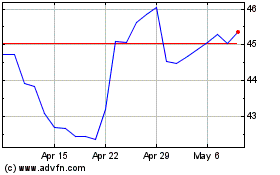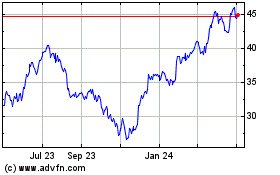By Nora Naughton and Mike Colias
The United Auto Workers scored major wins on wages, health care
and temporary workers in its new tentative labor pact with General
Motors Co., after calling a costly nationwide strike that has
halted work at the company's U.S. factories.
But GM will move forward with plans to close three idled U.S.
factories, including a plant in Lordstown, Ohio, that President
Trump had pressed the company to keep open. GM intends to sell the
Ohio factory to a startup electric-truck builder.
The strike will continue for now, pending a vote by a council of
UAW labor leaders gathered in Detroit. These UAW officials will
decide whether to end the strike immediately or continue it until
the proposed contract is ratified by rank-and-file members. A
decision was expected Thursday afternoon.
The strike, which is in its fifth week, is already the company's
longest nationwide walkout since 1970.
The agreement struck by union and company bargainers Wednesday
will move newer workers to the top wage in four years rather than
the eight years now, provide wage increases and lump-sum bonuses of
3% to 4% in each year of the contract and give temporary workers
full-time status after three years, according to details made
public Thursday.
The proposed contract, covering more than 46,000 UAW-represented
workers at GM, also includes a $11,000 bonus for full-time workers
if the deal is ratified, as well as a $4,500 signing bonus for
temporary workers, more than double their bonus in 2015.
The UAW succeeded in holding the line on health care, with the
3% contribution workers pay for their benefits unchanged. GM had
entered into talks looking to increase the cost-share to help
defray fast-rising medical costs that totaled roughly $900 million
last year for its union-represented workforce.
While analysts say the deal is likely to increase GM's labor
costs, the contract would also let GM trim excess factory capacity
in the U.S., long a drag on its bottom line. The company won the
formal go-ahead from the UAW to close three underused U.S.
factories that had weighed on profits.
During contract talks, UAW leaders had pressed GM to move more
factory production from Mexico to the U.S. -- even criticizing the
company publicly for not supporting American workers -- but the
agreement summary makes no such commitments.
Missing from the summary released Thursday by the UAW was a
breakdown of the money GM will invest in U.S. factories, which the
union has made sure to highlight in past contract deals.
As part of this agreement, GM has pledged roughly $7.7 billion
in new investments for its U.S. factories, creating or preserving
around 9,000 jobs, a UAW spokesman confirmed.
Kristin Dziczek, an economist and labor specialist at the Ann
Arbor, Mich.-based Center for Automotive Research, said she was
surprised the UAW didn't provide details on the new company
investment. "That has been how they convey job security to
workers," she said. "I don't know how that will go over."
The UAW didn't have an immediate comment on why those details
weren't included in the summary.
The plant closures, announced last November, drew sharp
condemnation from Mr. Trump and elected officials whose districts
were affected. GM Chief Executive Mary Barra has made several
visits to Washington, D.C., over the past year, in part to discuss
the restructuring plans with lawmakers.
Mr. Trump called Ms. Barra Wednesday to discuss the agreement
details, a GM spokesman confirmed, declining to elaborate. The
president also spoke with UAW President Gary Jones, the union
confirmed.
The factory cuts are central to a restructuring plan GM laid out
last year, aimed at boosting cash flow by $6 billion annually. A
fourth plant that GM had slated for closure will remain open,
eventually to build an electric pickup truck, people close to the
talks said.
"We see the agreement to close three out of the four plants
initially targeted as a 'win' for GM, keeping their restructuring
plan on track," said Jefferies analyst Philippe Houchois in an
investor note Thursday.
Still, any increase in labor costs for GM will likely be
replicated at Ford Motor Co. and Fiat Chrysler Automobiles NV, with
the UAW bargainers seeking to use the GM contract as a template to
reach similar agreements.
GM shares fell nearly 1% in afternoon trading Thursday. They
have fallen about 6% since the strike began.
Analysts estimate the strike has eroded GM's bottom line by $2
billion or more, and is likely to put a major dent in the company's
second-half results. GM is scheduled to report its third-quarter
results Oct. 29.
If approved by workers, the new GM-UAW labor pact will set the
framework for how these two big institutions navigate an expected
downturn in the U.S. car market and disruptive forces reshaping the
auto business, from the emergence of electric cars to self-driving
cars and ride-hailing ventures.
Still, winning their support isn't guaranteed. Ratification
could face challenges, particularly because nearly half of GM's
unionized workforce has never experienced an industry downturn and
will be less inclined to accept concessions, labor experts
said.
UAW officials entered negotiations already rattled by GM's
decision to close the plants, driven in part by the company's need
to steer capital toward bets on electric vehicles. Analysts say the
long-term shift toward battery-powered cars is a threat to
traditional factory jobs because they require fewer parts and less
manpower to assemble.
GM bargainers during negotiations assured union leaders that UAW
members would be in line for work and retraining related to new
technologies like electric and autonomous vehicles, according to
the union's summary of the contract.
A new committee of union and company officials will meet
regularly to discuss new technologies and how they might affect the
jobs of union workers, the union said.
Separate from the proposed contract, GM said Thursday it will
invest with partners in a battery-cell plant near the Lordstown
factory that would employ about 1,000 UAW-represented workers. The
sale of the factory to the electric-truck maker should create
around 400 jobs initially, the company said.
Write to Nora Naughton at nora.naughton@wsj.com and Mike Colias
at Mike.Colias@wsj.com
(END) Dow Jones Newswires
October 17, 2019 15:43 ET (19:43 GMT)
Copyright (c) 2019 Dow Jones & Company, Inc.
General Motors (NYSE:GM)
Historical Stock Chart
From Mar 2024 to Apr 2024

General Motors (NYSE:GM)
Historical Stock Chart
From Apr 2023 to Apr 2024
